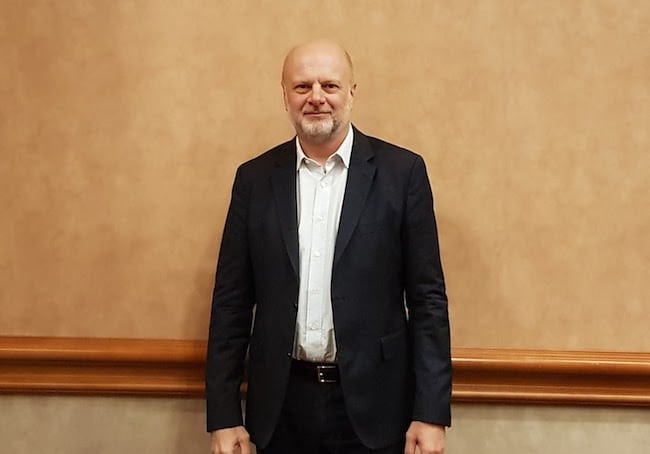The industrial ‘internet of things’ (IoT) market is geographically skewed, reckons one of its leading protagonists. Greg Kinsey, vice president of Japan-based Hitachi’s Vantara business, says the US is way behind, fixated on sensors in factories, while European countries rewrite the industrial rule-book with open technologies and collaborative working.
“We are witnessing a two-speed market,” explains Greg Kinsey, vice president at Hitachi Vantara, in an extensive interview with Enterprise IoT Insights, which will be published over several instalments. “The EU is about the digitisation of manufacturing operations and processes; the US is very focused on IoT.”
There are important differences, he notes. “The US is engaged in this conversation around IT stacks, which is very different to what we are talking about in Europe. Here, in Europe, the dialogue is about open-source collaboration and innovation.”
The differences are fundamental, he says. “The Americans just think digital is a new name for IT. And it’s not; it’s completely different. Europe understands that, and particularly France and Germany, and Sweden and Switzerland – where the really strong use cases are materialising.”
He adds: “I don’t see digital as a boardroom topic among American manufacturers to the same extent I see it in Europe. In Europe digital has been made a key strategic objective for every major executive. For CEOs in Europe, it is the most important thing they’re doing right now.”

Kinsey, an American in Paris, cites PwC research, that around 60 per cent of French corporations have appointed a chief digital officer; just 20 per cent of US firms have done the same, he says. “There is a deeper understanding of the difference between digital and IoT.”
The IoT messaging from technology firms does not resonate (“at all”) among the top 500 companies in Europe, says Kinsey. It doesn’t work in Hitachi’s home country, either. “Japan is more closely aligned with EU innovation.”
What about the UK, in search of a new industrial identity with its European divorce in process? “Yes, well, the UK sits, as it often does, somewhere between the EU and US; a kind of half-way orientation between the European and American models.”
The digital agenda has not just been raised up to boardroom level in Europe; it sits as a permanent fixture on government desks, a part of the political discussion about economic transformation. Kinsey points to Germany’s Industrie 4.0 movement, which makes industrial transformation a central part of the German government’s economic policy, and France’s parallel Alliance du Futur scheme.
French President Emmanuel Macron’s has pursued close alignment with the tech sector, as well, drawing it close with both fierce backing and gentle hectoring. He has just hosted certain members of the so-called ‘GAFA’-set – describing the US tech elite; nominally Google, Apple, Facebook and Amazon – to hammer out issues of data privacy and corporate tax.
His smartly presented €1.5 billion ($1.8bn) package on artificial intelligence (AI) at the end of March appears to have kicked the global political elite into action, or the European contingent at least.
The European Commission (EC) said in April it wants €20 billion ($23.9bn) of new innovation funds from governments and private enterprises to supplement its Horizon 2020 programme and stimulate the AI industry within the EU. The Brexit-bound UK announced a £1 billion ($1.4bn) joint investment shortly after to stimulate its own AI industry.
Meanwhile, an exploratory White House summit on AI earlier this month, which follows a general unravelling of former President Barack Obama’s early state guidance on AI, is yet to produce any clear policy or investment promises on tech-harnessed industrial strategy in the US. “There is such a high degree of government sponsorship of digital in Europe, which we don’t see at all in the US, where we don’t see any government sponsorship of digital at all,” says KInsey.
He goes on: “Automation and the connection of assets – that story has gone. The story in Europe is about what to do with the data – about the analytics and machine learning, and the business value from it. That’s the basis of the projects we’re doing in Europe and Japan.”
For Kinsey, Europe is able to innovate more freely in industrial settings precisely because it is culturally removed from the major ‘over-the-top’ (OTT) internet brands in the consumer market. “The US is very, very advanced in consumer digital – and all things related to GAFA, and advertising and selling things online. In Europe, we don’t have that, and the helps focus the mind-set, and think more clearly about industrial strategy.”
The US economic footprint is deeply divided as the digital elite congregate around a few high-tech clusters, notably in Silicon Valley, Seattle, Boston, and Austin, while old industrial ‘rust belt’ states like Ohio, Pennsylvania, and West Virginia fall behind.
“The culture is different; the politics are different – you see red states and blue states. The level of innovation is different, the education is different, even the way the money flows is different,” explains Kinsey.
“You know, there’s not a lot of venture-capital money chasing rust-belt innovations. Contrast that to what’s happening in Europe – in Paris, or Stuttgart, or Turin – where mechanical engineering and software are coming together, and money is being invested in tech specifically for manufacturing.”
“There’s not this cultural divide between high tech and low tech. In Europe, it’s all just industry – and it blends together the digital with the physical.”
This is an excerpt from a wide-ranging interview with Hitachi Vantara vice president Greg Kinsey. For more from the interview, check out the links below.
The IIoT interview (pt2): “Three is the magic number for digital ROI,” says Hitachi
The IIoT interview (pt3) “We’re selling innovations, not solutions,” says Hitachi
Drugs, steel and tyres: Three ‘predictive quality’ use cases from Hitachi
Planes, computers and books: Three ‘dynamic scheduling’ use cases from Hitachi
Motor cars and gas turbines: Two ‘predictive downtime’ use cases from Hitachi
